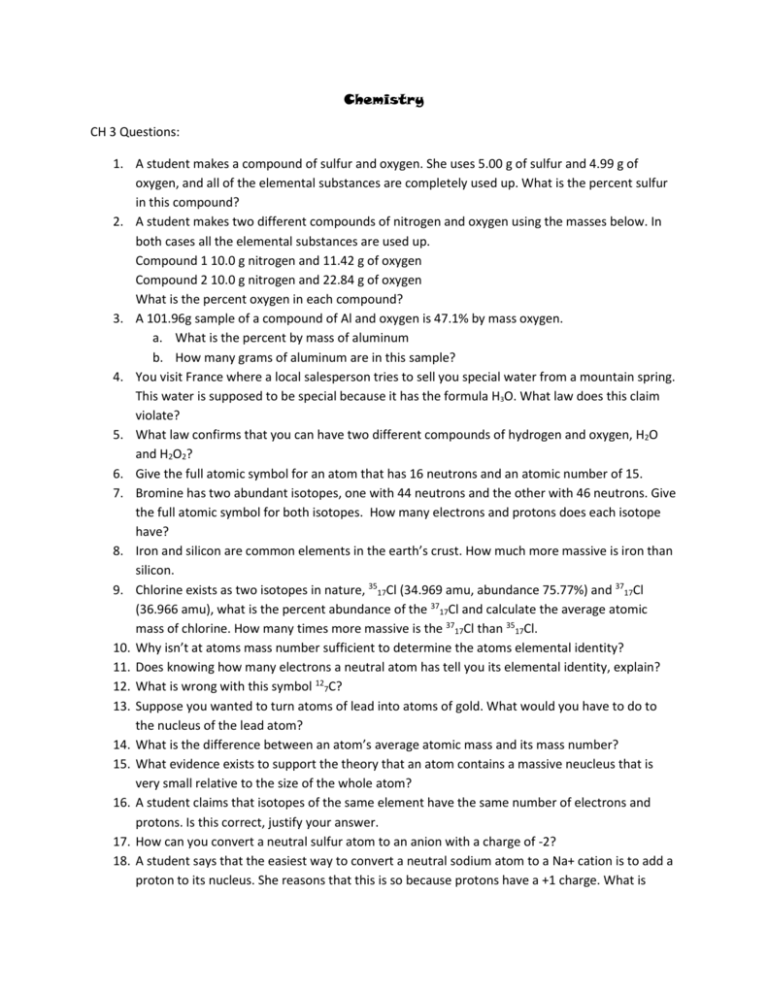CH 3 Mixed Questions
advertisement

Chemistry CH 3 Questions: 1. A student makes a compound of sulfur and oxygen. She uses 5.00 g of sulfur and 4.99 g of oxygen, and all of the elemental substances are completely used up. What is the percent sulfur in this compound? 2. A student makes two different compounds of nitrogen and oxygen using the masses below. In both cases all the elemental substances are used up. Compound 1 10.0 g nitrogen and 11.42 g of oxygen Compound 2 10.0 g nitrogen and 22.84 g of oxygen What is the percent oxygen in each compound? 3. A 101.96g sample of a compound of Al and oxygen is 47.1% by mass oxygen. a. What is the percent by mass of aluminum b. How many grams of aluminum are in this sample? 4. You visit France where a local salesperson tries to sell you special water from a mountain spring. This water is supposed to be special because it has the formula H3O. What law does this claim violate? 5. What law confirms that you can have two different compounds of hydrogen and oxygen, H2O and H2O2? 6. Give the full atomic symbol for an atom that has 16 neutrons and an atomic number of 15. 7. Bromine has two abundant isotopes, one with 44 neutrons and the other with 46 neutrons. Give the full atomic symbol for both isotopes. How many electrons and protons does each isotope have? 8. Iron and silicon are common elements in the earth’s crust. How much more massive is iron than silicon. 9. Chlorine exists as two isotopes in nature, 3517Cl (34.969 amu, abundance 75.77%) and 3717Cl (36.966 amu), what is the percent abundance of the 3717Cl and calculate the average atomic mass of chlorine. How many times more massive is the 3717Cl than 3517Cl. 10. Why isn’t at atoms mass number sufficient to determine the atoms elemental identity? 11. Does knowing how many electrons a neutral atom has tell you its elemental identity, explain? 12. What is wrong with this symbol 127C? 13. Suppose you wanted to turn atoms of lead into atoms of gold. What would you have to do to the nucleus of the lead atom? 14. What is the difference between an atom’s average atomic mass and its mass number? 15. What evidence exists to support the theory that an atom contains a massive neucleus that is very small relative to the size of the whole atom? 16. A student claims that isotopes of the same element have the same number of electrons and protons. Is this correct, justify your answer. 17. How can you convert a neutral sulfur atom to an anion with a charge of -2? 18. A student says that the easiest way to convert a neutral sodium atom to a Na+ cation is to add a proton to its nucleus. She reasons that this is so because protons have a +1 charge. What is 19. 20. 21. 22. 23. 24. 25. wrong with this argument? What does a neutral Na atom become when a proton is added to its nucleus? The mass number of a +2 cation is 56 and its atomic number is 26. The ion contains how many protons, electrons and neutrons. What is the identity of element X if its +2 cation contains ten electrons? Write the full atomic symbol for each isotope: a. 8 protons and 9 neutrons b. 12 neutrons, atomic number 11 c. 28 protons, mass number 58 d. 81 neutrons, symbol Ba If a scientist during Dalton’s time found that hydrogen sulfide always has the formula H2S, how would this have been explained? How did Rutherford interpret the observation that only a very few of the alpha particles were scattered by the gold foil? How much more massive is the oxygen atom than the helium atom? Which law supports the view that the formula of salt is NaCl no matter where you find it or how much you have of it and what law supports the view that when carbon reacts with oxygen it can get together as CO or CO2?








